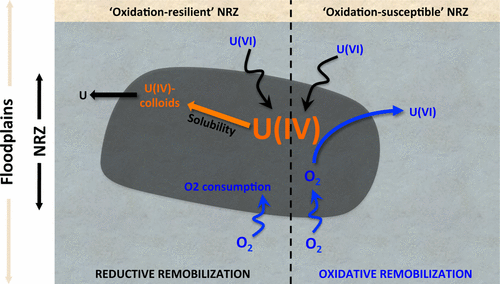当前位置:
X-MOL 学术
›
Environ. Sci. Technol.
›
论文详情
Our official English website, www.x-mol.net, welcomes your
feedback! (Note: you will need to create a separate account there.)
Redox Controls over the Stability of U(IV) in Floodplains of the Upper Colorado River Basin
Environmental Science & Technology ( IF 10.8 ) Pub Date : 2017-09-21 00:00:00 , DOI: 10.1021/acs.est.7b02203 Vincent Noël 1 , Kristin Boye 1, 2 , Juan S. Lezama Pacheco 1, 2 , Sharon E. Bone 1 , Noémie Janot 1 , Emily Cardarelli 2 , Kenneth H. Williams 3 , John R. Bargar 1
Environmental Science & Technology ( IF 10.8 ) Pub Date : 2017-09-21 00:00:00 , DOI: 10.1021/acs.est.7b02203 Vincent Noël 1 , Kristin Boye 1, 2 , Juan S. Lezama Pacheco 1, 2 , Sharon E. Bone 1 , Noémie Janot 1 , Emily Cardarelli 2 , Kenneth H. Williams 3 , John R. Bargar 1
Affiliation

|
Aquifers in the Upper Colorado River Basin (UCRB) exhibit persistent uranium (U) groundwater contamination plumes originating from former ore processing operations. Previous observations at Rifle, Colorado, have shown that fine grained, sulfidic, organic-enriched sediments accumulate U in its reduced form, U(IV), which is less mobile than oxidized U(VI). These reduced sediment bodies can subsequently act as secondary sources, releasing U back to the aquifer. There is a need to understand if U(IV) accumulation in reduced sediments is a common process at contaminated sites basin-wide, to constrain accumulated U(IV) speciation, and to define the biogeochemical factors controlling its reactivity. We have investigated U(IV) accumulation in organic-enriched reduced sediments at three UCRB floodplains. Noncrystalline U(IV) is the dominant form of accumulated U, but crystalline U(IV) comprises up to ca. 30% of total U at some locations. Differing susceptibilities of these species to oxidative remobilization can explain this variability. Particle size, organic carbon content, and pore saturation, control the exposure of U(IV) to oxidants, moderating its oxidative release. Further, our data suggest that U(IV) can be mobilized under deeply reducing conditions, which may contribute to maintenance and seasonal variability of U in groundwater plumes in the UCRB.
中文翻译:

科罗拉多河上游流域平原中U(IV)稳定性的氧化还原控制
上科罗拉多河盆地(UCRB)的含水层显示出持久的铀(U)地下水污染羽状流,这些羽状流源于以前的矿石加工活动。以前在科罗拉多州的来福枪(Rifle)的观测表明,细颗粒,硫化物,富含有机物的沉积物以还原形式的铀(U(IV))堆积,其流动性低于氧化的U(VI)。这些减少的沉积物体随后可以充当次要来源,将U释放回含水层。有必要了解减少的沉积物中的U(IV)积累是否是整个盆地受污染地点的常见过程,以限制积累的U(IV)物种,并确定控制其反应性的生物地球化学因素。我们研究了三个UCRB洪泛区富含有机物的还原沉积物中的U(IV)积累。非晶态的U(IV)是累积的U的主要形式,但晶态的U(IV)最多可包含约。在某些位置,占总U的30%。这些物种对氧化固定的敏感性不同,可以解释这种变异性。颗粒大小,有机碳含量和孔隙饱和度可控制U(IV)暴露于氧化剂,从而减缓其氧化释放。此外,我们的数据表明,U(IV)可以在深度减少的条件下动员,这可能有助于UCRB中地下水羽流中U的维持和季节变化。减轻其氧化释放。此外,我们的数据表明,U(IV)可以在深度减少的条件下动员,这可能有助于UCRB中地下水羽流中U的维持和季节变化。减轻其氧化释放。此外,我们的数据表明,U(IV)可以在深度减少的条件下动员,这可能有助于UCRB中地下水羽流中U的维持和季节变化。
更新日期:2017-09-21
中文翻译:

科罗拉多河上游流域平原中U(IV)稳定性的氧化还原控制
上科罗拉多河盆地(UCRB)的含水层显示出持久的铀(U)地下水污染羽状流,这些羽状流源于以前的矿石加工活动。以前在科罗拉多州的来福枪(Rifle)的观测表明,细颗粒,硫化物,富含有机物的沉积物以还原形式的铀(U(IV))堆积,其流动性低于氧化的U(VI)。这些减少的沉积物体随后可以充当次要来源,将U释放回含水层。有必要了解减少的沉积物中的U(IV)积累是否是整个盆地受污染地点的常见过程,以限制积累的U(IV)物种,并确定控制其反应性的生物地球化学因素。我们研究了三个UCRB洪泛区富含有机物的还原沉积物中的U(IV)积累。非晶态的U(IV)是累积的U的主要形式,但晶态的U(IV)最多可包含约。在某些位置,占总U的30%。这些物种对氧化固定的敏感性不同,可以解释这种变异性。颗粒大小,有机碳含量和孔隙饱和度可控制U(IV)暴露于氧化剂,从而减缓其氧化释放。此外,我们的数据表明,U(IV)可以在深度减少的条件下动员,这可能有助于UCRB中地下水羽流中U的维持和季节变化。减轻其氧化释放。此外,我们的数据表明,U(IV)可以在深度减少的条件下动员,这可能有助于UCRB中地下水羽流中U的维持和季节变化。减轻其氧化释放。此外,我们的数据表明,U(IV)可以在深度减少的条件下动员,这可能有助于UCRB中地下水羽流中U的维持和季节变化。









































 京公网安备 11010802027423号
京公网安备 11010802027423号